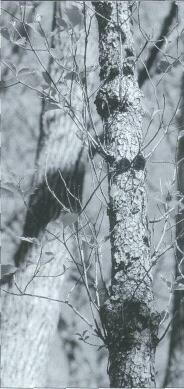 |
Home | Search | Browse | About IPO | Staff | Links |
 |
Home | Search | Browse | About IPO | Staff | Links |
|
The Plight of the Dogwood A foreign fungus threatens one of Illinois' prettiest trees.
BY WILLIAM MCCLAIN AND TERRY ESKER
Is there a prettier tree in spring than the flowering dogwood? This small tree's magnificent white blossoms overlap the flowering of redbud, creating a spectacular floral display.
Because this species rarely exceeds 25 feet in height, it is usually overshadowed by larger hardwoods in forest communities. Within the nursery trade, it is a very popular and important plant that is widely planted as an ornamental.
But just as important as its beauty is its brilliant red fruit that is an important food source for many birds, squirrels, chipmunks and wild turkeys.
The dogwood is especially common in the southern half of Illinois, where it flourishes in the hardwood forests. But concern began to develop for this species in the early 1980s, when reports from the east coast documented the death of numerous flowering dogwoods due to some "mysterious disease." Initially, plant pathologists considered the disease outbreak to be nothing more than a known pathogen whose effects were magnified by several especially wet springs. But the disease continued to spread rapidly, and plant disease experts were prompted to examine the dogwoods more closely. The result was the discovery of a previously unknown disease of flowering dogwoods that may have been introduced into this county from
2 OutdoorIllinois

Asia on specimens of the Asiatic dogwood.
In 1987, this dogwood disease was being found in Maryland, Delaware, Massachusetts, Virginia and West Virginia. By May 1988, it had reached the high elevations of the Appalachian Mountains of North Carolina, South Carolina and Tennessee. By 1992, the disease was estimated to cover nearly 13 million acres of the range of flowering dogwood.
It reached Illinois in 1995, when botanists discovered that numerous flowering dogwoods had died at the Dean Hills Nature Preserve in Fayette County. By 1998, the disease also was found in Washington, Jersey, Calhoun, Coles and Pope counties.
The blight affecting dogwoods is one of many different diseases known collectively as anthracnoses. The symptoms occur approximately four weeks after flowering, and include leaf blotches with reddish or brown-purple margins, twig dieback and the formation of clusters of epicormic branches. Open cankers are often found on the trunks and larger branches. Infected leaves often wilt and fall prematurely from the tree. If adjacent cankers join, they can girdle the tree, resulting in its death.
As was done for the American chestnut in previous decades, seed has been collected from sites within the range of flowering dogwood in hopes of finding trees that are resistant to the disease. Although there have been dramatic losses of flowering dogwoods within many forest communities, it is unlikely that all individuals will be eliminated. Those plants that are growing on the drier, more exposed sites, where air circulation is better, have the greatest potential for survival. The intensity of the disease is also likely to fluctuate with the climate. Damp, cool spring seasons will favor the spread and severity of the disease, while dry conditions will help curtail it. Landowners can help prevent the spread of this disease by increasing the sunlight and air circulation. Trees should also be watered during times of drought because stressed or weakened trees are more susceptible to disease. However, care should be taken to avoid wetting the foliage when watering because this will facilitate the advancement of the disease. It has been nearly 20 years since this disease made its initial appearance in the northeastern woods. Some dogwoods continue to survive in these forests, but in much-reduced densities. Still, the final impact of the affliction upon native dogwood populations has yet to be determined. If the dogwood anthracnose fungus is found to be another exotic invader as some suspect, it will underscore its negative impact upon natural communities and the necessity of preventing its entry into this country. Dogwood anthracnose has already diminished food and nesting sites for wildlife and created much less colorful springs within much of the eastern forests. September 2000 3 |
|
|